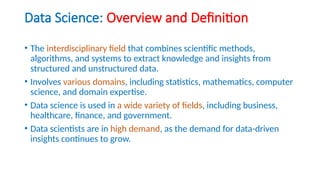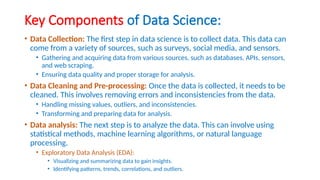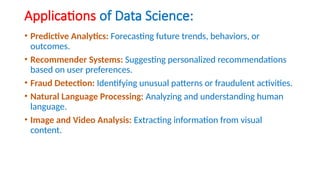Introduction to Data Science for iSchool KKU
- 1. Introduction to Data Science
- 2. Data Science: Overview and Definition ŌĆó The interdisciplinary field that combines scientific methods, algorithms, and systems to extract knowledge and insights from structured and unstructured data. ŌĆó Involves various domains, including statistics, mathematics, computer science, and domain expertise. ŌĆó Data science is used in a wide variety of fields, including business, healthcare, finance, and government. ŌĆó Data scientists are in high demand, as the demand for data-driven insights continues to grow.
- 3. Key Components of Data Science: ŌĆó Data Collection: The first step in data science is to collect data. This data can come from a variety of sources, such as surveys, social media, and sensors. ŌĆó Gathering and acquiring data from various sources, such as databases, APIs, sensors, and web scraping. ŌĆó Ensuring data quality and proper storage for analysis. ŌĆó Data Cleaning and Pre-processing: Once the data is collected, it needs to be cleaned. This involves removing errors and inconsistencies from the data. ŌĆó Handling missing values, outliers, and inconsistencies. ŌĆó Transforming and preparing data for analysis. ŌĆó Data analysis: The next step is to analyze the data. This can involve using statistical methods, machine learning algorithms, or natural language processing. ŌĆó Exploratory Data Analysis (EDA): ŌĆó Visualizing and summarizing data to gain insights. ŌĆó Identifying patterns, trends, correlations, and outliers.
- 4. Key Components of Data Science (continued): ŌĆó Statistical Analysis and Machine Learning: ŌĆó Applying statistical techniques and algorithms to make predictions and decisions based on data. ŌĆó Training models, evaluating their performance, and selecting the best ones for the problem at hand. ŌĆó Data Visualization: The final step is to visualize the data. This helps to communicate the findings of the analysis to others. ŌĆó Creating meaningful and informative visual representations of data. ŌĆó Communicating findings and insights effectively. ŌĆó Communication and Storytelling: ŌĆó Presenting results and insights to stakeholders in a clear and understandable manner. ŌĆó Translating technical concepts into actionable recommendations.
- 5. Applications of Data Science: ŌĆó Predictive Analytics: Forecasting future trends, behaviors, or outcomes. ŌĆó Recommender Systems: Suggesting personalized recommendations based on user preferences. ŌĆó Fraud Detection: Identifying unusual patterns or fraudulent activities. ŌĆó Natural Language Processing: Analyzing and understanding human language. ŌĆó Image and Video Analysis: Extracting information from visual content.
- 6. Tools and Technologies for Data Science ŌĆó There are a variety of tools and technologies that can be used for data science. Some of the most popular tools include Python, R, Rapid Miner, Weka, and Hadoop. ŌĆó These tools can be used to collect, clean, analyze, and visualize data. ŌĆó There are also a number of cloud-based platforms that offer data science tools and services.
- 7. Skills and Tools in Data Science: ŌĆó Programming languages: Python, R, SQL. ŌĆó Data manipulation and analysis: Pandas, NumPy, SQL. ŌĆó Machine learning libraries: scikit-learn, TensorFlow, Keras. ŌĆó Data visualization: Matplotlib, Seaborn, Tableau. ŌĆó Big Data processing: Apache Spark, Hadoop. ŌĆó Version control: Git, GitHub.
- 8. The Future of Data Science ŌĆó The field of data science is constantly evolving. ŌĆó New tools and technologies are being developed all the time. ŌĆó The demand for data scientists is expected to continue to grow in the coming years.
- 9. Challenges and Ethical Considerations: ŌĆó Data Privacy: Safeguarding sensitive information and user privacy. ŌĆó Bias and Fairness: Ensuring algorithms and models are fair and unbiased. ŌĆó Data Security: Protecting data from unauthorized access and breaches. ŌĆó Ethical Use of Data: Considering the social and ethical implications of data-driven decisions.
- 10. Conclusion: ŌĆó Data Science is a rapidly evolving field with diverse applications. ŌĆó It combines various disciplines to extract valuable insights from data. ŌĆó Acquiring the necessary skills and using the right tools is crucial for success. ŌĆó Ethical considerations and responsible data practices are essential.










